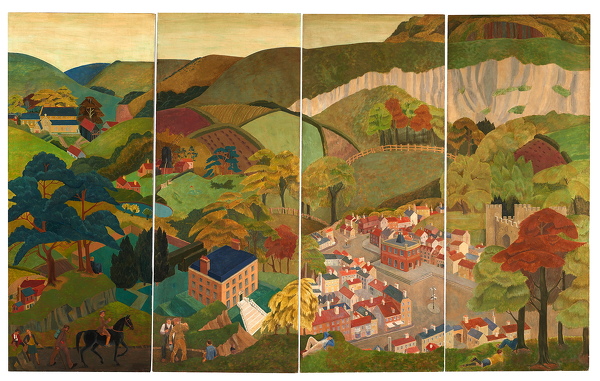

 Hover over the painting to magnify (there may be an initial delay while the magnified image is loaded)
Hover over the painting to magnify (there may be an initial delay while the magnified image is loaded)Margaret L. Duncan (1906 - 1979):
Reigate and its Environments, late 1930's
Unframed (ref: 9655)
Tempera on panel, mounted on four panels
See all works by Margaret L. Duncan panel tempera landscape topography women 1.Master Designs 49 pictures Fifty Works by Fifty British Women Artists 1900 - 1950 Garden Museum Rediscovering Women Artist WOMEN
Provenance: Private Collection
Exhibited: 'For Real: British Realists from the 20s and 30s', Museum MORE, Gorssel (September 15th, 2019 – January 5th, 2020).
Little is known about Margaret Duncan, other than that she worked as an art teacher at Huyton College (1935–1947), moving from there to St Katharine’s College, Tottenham. She exhibited a painting, The Annunciation, at the Royal Academy in 1941. This painted screen, presumably for domestic use, may be a little earlier than her RA exhibit, although its deliberately pastoral feel – no vehicles or other modern conveniences are shown – makes it hard to be sure.
A preliminary sketch labelled “Design for Mural Decoration” helps with the identification of features. Duncan probably took her view from the tower of St Mary’s Church, to the east of Reigate, looking roughly north-west across the town but moving the North Downs to form a backdrop. On the right is the abandoned chalk pit biting into the flank of Reigate Hill, with Colley Hill and Box Hill to its left (west). Prominent among the town’s buildings are the former Town Hall of c.1728 and the gothic gatehouse folly of 1777 on the site of Reigate’s Norman castle. In the left foreground is Reigate Park (labelled on the sketch). One curiosity is that the prominent building beyond, set in a sunken formal garden, is there labelled “Reigate Priory”. However, this is clearly not that, but apparently Cherchefelle, a five-bay house of c.1770 in Chart Lane, close to St Mary’s Church. Did Duncan assemble this view from a series of individual sketches and inadvertently get two buildings muddled up?
Commentary by Paul Stamper, landscape historian, specialising in the post-Roman countryside. After a career with the Victoria County History and English Heritage, he now runs his own heritage consultancy — Paul Stamper Heritage.
Exhibited: Sanctuary, Artist-Gardeners, 1919-39, Garden Museum, London, 25th February – 5 April, 2020
Literature: Christopher Woodward, Sanctuary: Artist-Gardeners, 1919–1939, published by Liss Llewellyn, 2020
 Unsung Heroines
Unsung Heroines




